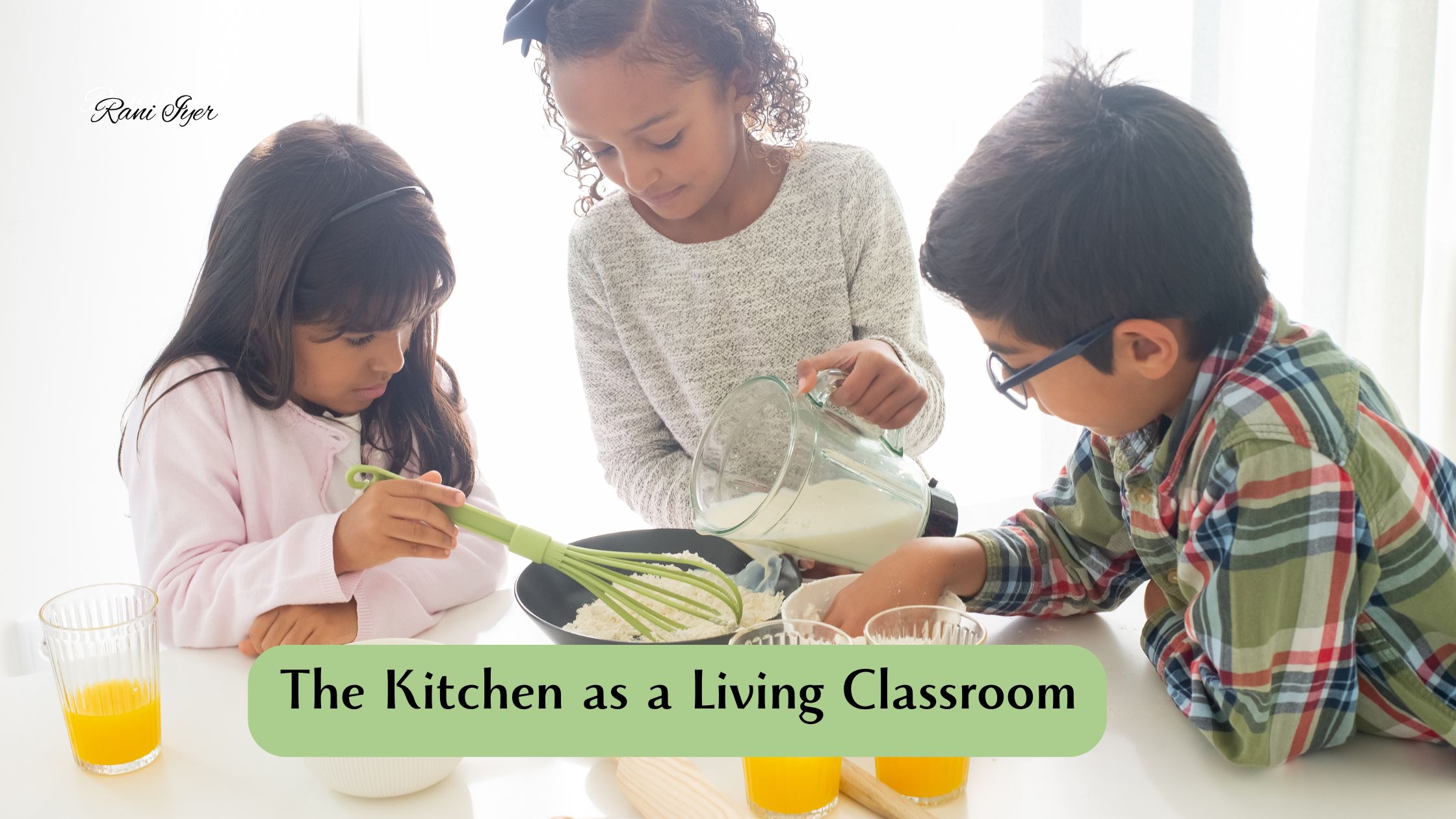The clink of copper pots. The warm scent of turmeric blooming in ghee. A pinch of wild mustard seeds dancing in a hot pan. For many of us, the kitchen is a place of nourishment, memory, and tradition. But look closer—your spice rack, pantry, and produce bowl are more than culinary staples. They are a living testament to biodiversity, ecology, geography, and the interconnectedness of our world.
In every humble kitchen—whether rural or urban, Indian or international—there’s a profound opportunity to appreciate the planet’s rich biological and cultural diversity. What we cook, where it comes from, and how it’s grown all tell a deeper story about who we are and the Earth we share.
Our kitchens are more than utilitarian spaces. They are microcosms of the planet—a fragrant, flavorful reflection of biodiversity, geography, and culture. Each spice on the shelf, grain in the jar, and fruit in the bowl holds a story that stretches across continents and centuries. Appreciating diversity in the kitchen isn’t just a matter of taste—it’s a powerful entry point into conversations about ecology, environmental sustainability, and cultural interconnectedness.
In an age of climate disruption and cultural homogenization, the humble kitchen offers a tangible, delicious way to reconnect with our roots and our responsibility to the Earth.
The Kitchen as a Mirror of Biodiversity
Every meal we prepare is a testimony to the abundance of life on this planet. Think of turmeric, native to the Indian subcontinent, used for centuries not just for flavor but also for its medicinal properties. Consider quinoa, a sacred grain of the Andes, or teff from the Ethiopian highlands. These aren’t just ingredients; they are outcomes of millennia of co-evolution between humans and the ecosystems they inhabit.
By choosing diverse ingredients—millets instead of rice, amaranth instead of wheat, jackfruit instead of processed meat—we make space for biological diversity in our diets and on our farms. These choices ripple outward. Diverse diets encourage farmers to grow a greater variety of crops, which in turn supports pollinators, soil health, and climate resilience.
Geography on Your Plate
Where our food comes from matters. The journey of vanilla from Madagascar, cinnamon from Sri Lanka, or cacao from the Amazon Basin is not merely geographic—it is ecological and historical. These plants evolved in unique biomes shaped by rainfall, altitude, soil chemistry, and human cultivation.
A kitchen rich in global flavors becomes a living geography lesson. Teaching children to cook with spices from across the globe can be the beginning of deeper conversations about tropical rainforests, ocean currents, or migratory pollinators. How does saffron thrive only in arid lands like Iran or Kashmir? Why does wild rice grow only in freshwater marshes? With every recipe, we open a window to the world.
Culinary Diversity as Cultural Ecology
Culture and ecology are inseparable. Food is a profound expression of place—climate, soil, season, and tradition converging on a plate. From fermented foods in cold climates to spice-heavy dishes in tropical zones, human creativity has always worked in harmony with nature’s constraints.
When we embrace diverse cuisines—South Indian dosas, Korean kimchi, Nigerian jollof—we engage in a quiet act of resistance against the flattening forces of globalization. Fast food chains and monoculture agriculture erase the delicate tapestry of cultural and ecological specificity. Our kitchen, however, can protect and revive it.
Even a simple act like saving seeds from heirloom tomatoes, or using a grinding stone instead of a processor, ties us to ancestral wisdom and slower rhythms of living. It is a daily practice of sustainability.
From Soil to Stomach: Ecology of Eating
What we eat affects the planet. A kitchen that values ecological integrity will prioritize seasonal, local, and organically grown produce. Composting kitchen scraps, reducing plastic packaging, growing herbs on a windowsill—all are expressions of a kitchen ecology that honors Earth’s limits.
Yet beyond the visible actions is the deeper shift in consciousness: seeing food not as a commodity, but as a connection—to farmers, to forests, to fungi, to future generations. This is the root of ecological thinking.
Building a Conscious Kitchen
Here are a few simple but profound ways to celebrate biodiversity and ecology in your kitchen:
- Cook with native grains: Support local farmers growing millet, sorghum, and indigenous legumes.
- Learn the story of your ingredients: Who grows your rice? Where is your pepper harvested?
- Host “global potlucks”: Encourage friends to bring dishes that reflect their cultural and ecological heritage.
- Start a kitchen garden: Even a balcony can grow herbs like basil, tulsi, or curry leaf.
- Preserve food the old way: Ferment, pickle, sun-dry. These methods reduce waste and connect us to seasonal cycles.
- Teach children where food comes from: Bring them to farmers markets, show them seed catalogs, let them help in cooking.
A Global Map in Your Pantry
Open your spice drawer. What do you see? Black pepper from the Malabar coast. Cinnamon that may trace its roots to Sri Lanka. Cumin, coriander, and cloves that crisscrossed ancient trade routes. In every jar, there is geography, history, and ecology.
These spices aren’t just flavorings—they are botanical treasures shaped by the climates, soils, and seasons of their native lands. Turmeric, for example, thrives in the rich loamy soils of tropical India, demanding consistent rainfall and warm temperatures. It’s a root that connects Ayurveda to the Amazon, as global researchers uncover its health benefits in fighting inflammation and disease.
Kitchen biodiversity isn’t only about spices. Think of heirloom rice from Tamil Nadu, lentils from the Deccan plateau, or millets—once overlooked, now rediscovered as climate-resilient superfoods. The grains on your plate reflect millennia of ecological adaptation and human ingenuity.
Cooking as an Ecological Act
Every choice we make in the kitchen—what we cook, how we source it, and how we dispose of waste—is an ecological act. The ecology of food extends beyond farmland and forest into our daily lives.
When we choose local produce, we reduce the carbon footprint of our meals. When we grow our own herbs, we contribute to urban biodiversity. When we save seeds, compost vegetable scraps, or support organic farmers, we become part of a larger movement that respects the natural world.
Your kitchen can become a model for sustainable living. Simple habits—like switching from plastic to cloth storage, using native grains, and reusing greywater—demonstrate how domestic spaces can support ecological balance.
The Language of Seeds and Soil
Let’s not forget: the diversity in our kitchens begins with diversity in our fields. India alone is home to over 60,000 varieties of rice—yet most of us cook only one or two. This narrowing of choice is not just a culinary issue, but a biodiversity crisis. Monocultures are replacing traditional crops, threatening soil health and farmers’ resilience.
By seeking out and cooking with indigenous grains, seasonal vegetables, and underutilized legumes, we actively support agrobiodiversity. Millets like ragi, bajra, and jowar are not only hardy and nutritious—they are heritage foods tied to water conservation, climate resilience, and cultural identity.
This is where the kitchen becomes a space of education. Involve your children in soaking rajma, sprouting mung, or learning the names of native plants. Through food, we can pass down a language of ecological respect and cultural continuity.
Food as Storytelling: Honoring Cultural Geography
Every recipe carries the fingerprint of place. Sambhar from Tamil Nadu is different from sambhar in Karnataka or Sri Lanka—because the land shapes the ingredients, and the ingredients shape the people.
By celebrating cultural diversity through cooking, we honor the geographical uniqueness of regions. We create awareness that what grows in Kerala’s backwaters may not thrive in Ladakh’s cold deserts. Understanding food through the lens of geography helps us appreciate local adaptations, encourages us to cook seasonally, and deepens our gratitude for each bite.
Let’s ask ourselves: what can we learn from a Punjabi thali about riverine agriculture? What does a Manipuri salad teach us about forest foraging? The kitchen becomes a canvas where cultural ecology is celebrated, not erased.
From Kitchen to Conservation: Becoming Stewards
Appreciating diversity in the kitchen is not a passive act—it is a call to stewardship. Our choices, conversations, and curiosity can support local farmers, protect vanishing food varieties, and build resilience in our food systems.
Start small:
- Visit a local farmer’s market and ask about indigenous crops.
- Plant native herbs like tulsi, curry leaf, or ajwain in your balcony.
- Join seed-sharing communities or host a recipe exchange highlighting regional grains.
Let your kitchen be your personal ecosystem—where you not only cook, but converse about climate, conservation, and cultural continuity.
The Final Simmer
When we see our kitchen as a microcosm of the world, we begin to cook with consciousness. We understand that food is not just fuel—it is a story of soil and sun, a reflection of human migration, and a living archive of biodiversity.
So the next time you stir a pot of dal, peel an onion, or boil rice, pause and listen. Your kitchen is speaking the language of the Earth.
In celebrating diversity in the kitchen, we are not just embracing a world of flavors—we are honoring the interdependence of life. We are creating a space of belonging, where every spice, every recipe, every story has a place. This is the kind of ecology that begins at home, rooted in mindfulness, blossoming into a more just and beautiful world.
The kitchen, after all, is not just where we cook. It is where we remember, reconnect, and reimagine our relationship with the Earth and each other.


